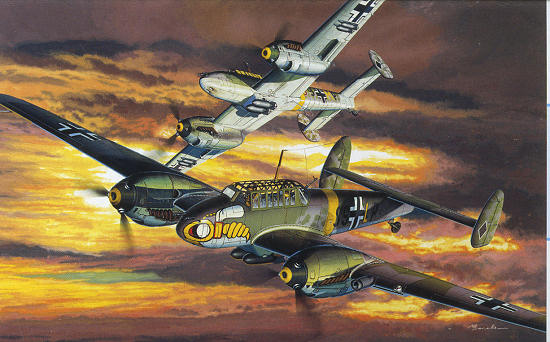
Dragon 1/32 Bf-110C-7
| KIT #: | 3203 |
| PRICE: | $109.00 MSRP |
| DECALS: | Two options |
| REVIEWER: | Scott Van Aken |
| NOTES: | Brand new molding. Gone are the rivets! Hooray! |

| HISTORY |
A total of at least seven major revisions of the Bf 110C existed. The Bf 110C was the first Bf 110 to see widespread combat and enjoyed some success in the Polish and French campaigns.
The Bf 110 Zerstörerwaffe (Destroyer Force) saw considerable action during operation Operation Weserübung the invasion of Denmark and Norway. Two Zerstörergeschwader (1 and 76) were committed with 64 aircraft. The Bf 110 destroyed 25 Danish military aircraft stationed on the Værløse airbase on 9 April through ground strafing. One Danish Fokker D.XXI did manage to get airborne but was immediately shot down. During this campaign, Victor Mölders, brother of the famous Werner Mölders, took the official surrender of the town of Aalborg after landing at the local airfield. Dressed in flying gear, he was given a lift into the town centre by a milkman to find suitable quarters for I.ZG 1's Bf 110 crews.
In Norway the Bf 110s helped secure the Oslo-Fornebu airport, escorting Junkers Ju 52 transports loaded with paratroops (Fallschirmjäger). The Germans were engaged by several Gloster Gladiators and machine guns manned by troops on the ground; in the ensuing battle both sides lost two aircraft.The Messerschmitt pilots did not know that many earlier waves of transports had turned back and the airport was unsecured. Landing their cargoes, many transports were destroyed. The remaining Bf 110s strafed the airfield and helped the ground troops take the airfield; the air support provided by the Zerstörer was instrumental, and it was to perform well as a fighter-bomber in the coming campaigns. During these battles, a future 110-kill Luftwaffe ace, Helmut Lent, scored his fifth and sixth victories against Norwegian opposition.
With experience fighting in Norway, efforts were made to extend the combat range of the Bf 110; these became the Bf 110D Long Range (Langstrecken) Zerstörer. Several different external fuel tanks, in the shape of 900 litre underwing-mounted and 1050-litre centerline ventral fuel tanks, resulted in no less than four versions of the Bf 110D, including the enormous Dackelbauch tank, which owing to cold weather and limited knowledge of fuel vapours, sometimes exploded, leading to unexplained losses during the North Sea patrols. As a result, the aircrews came to dislike this version. The handling characteristics were also affected; the Bf 110 was not maneuverable to begin with and the added weight made it worse.
Luckily the Zerstörerwaffe encountered mostly British bombers, and it performed well. On 13 June 1940, eight Skua dive-bombers were shot down in as many minutes; among the victors was Herbert Schob who survived the war as one of the most successful Bf 110 pilots. Total losses during this campaign amounted to only 20.
The campaign in the west that followed in 1940 demonstrated the Bf 110 was vulnerable in hostile skies. It performed well against the Belgian, Dutch and French Air Forces, suffering relatively light losses, but was quickly outclassed by increasing numbers of Hurricanes and Spitfires. In the Western Campaign, 60 were lost.
When used in the Battle of Britain, 110 units suffered very high losses and were quickly pulled from escort duty and turned into fighter bombers and fast reconnaissance aircraft. In other theaters, where the opposition wasn't as strong, the 110 did well and finally found its niche as a night fighter, but that is another story.
The Bf-110C-7 and subject of this kit, was built concurrently with the C-4 and D variants. It was basically a C-4B with the addition of a centerline bomb rack and uprated DB. 601P engines.
| THE KIT |
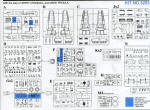 Many
modelers felt that Dragon screwed the pooch with their 1/32 Mustang kits. There
were a number of problems with the shape of some parts, but most of all it was
the aggressive surface detailing that caused the most fuss. Though the kit has
sold well, it could have done better.
Many
modelers felt that Dragon screwed the pooch with their 1/32 Mustang kits. There
were a number of problems with the shape of some parts, but most of all it was
the aggressive surface detailing that caused the most fuss. Though the kit has
sold well, it could have done better.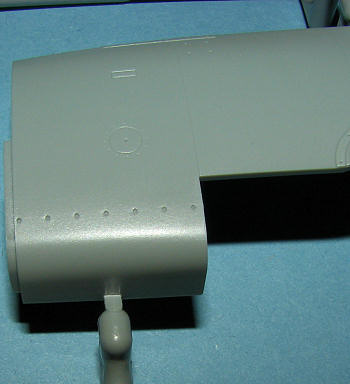
This time around, Dragon seems to have done everything right. Gone is the Trumpeter-like surface detailing, leaving something more like what Hasegawa might have done and that is a very good thing. The surface detailing is crisply engraved and a far cry from what was. You can see this on the section shown at the right. The kit also has a ton of interior detailing as well as nicely done wheels wells.
Apparently the thing to offer on these kits is additional detailing. To that length, Dragon has provided a fully detailed nose gun bay. Thanks to a single piece nose molding, one simply slips it off to show the four guns. There are also a pair of fully detailed engines provided for you. One will have the ability to show this with panels off or to keep them closed up. Since two engines are provided, the enthusiastic modeler can have them both exposed as if going through a major overhaul or inspection. The lazy among us will undoubtedly use just enough of the engine to support the exhaust and the prop, leaving the covers closed.
Interior is superbly detailed with all the radio boxes and other bits needed. There are photo etch harnesses/belts for the all the crew. Also in photo etch is the DF loop antenna. One could use the plastic one, but the 'double' ring antenna one can do with the photo etch is much more realistic. Thanks to duplicating the harness, one has a spare. Clear parts are also crisply molded and in sections so one can pose the various areas open to show off the interior.
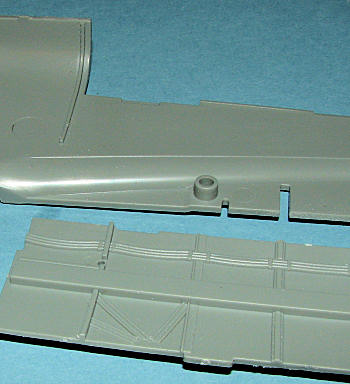 In
addition to all the guns, there are centerline and wing racks for the bombs. Of
course, when fully loaded the range would be short, but it is possible to fully
load the aircraft. As this is large scale, there are a lot of smaller parts to
install, but that just adds to the detail level.
In
addition to all the guns, there are centerline and wing racks for the bombs. Of
course, when fully loaded the range would be short, but it is possible to fully
load the aircraft. As this is large scale, there are a lot of smaller parts to
install, but that just adds to the detail level.
As you know, many modern kits do not use discreet pins and sockets
for parts alignment on the fuselage and this is no exception. There are tiny
tabs and indentations on the fuselage and wing leading edge to help out. This
prevents sink areas. There are, however, large pins and sockets for installing
the interior sidewalls. You can see these details in the image to your left.
Fortunately, the fuselage exterior is totally free from any mold glitches and
that is true of the rest of the sprues that I inspected.
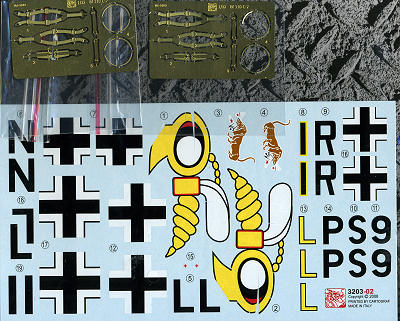
Instructions are superbly done with Gunze and Model Master paint references. There are detail bits to the various construction steps where needed. I'm sure there is a part number glitch somewhere in there, but I won't know where it is until I am working on the kit. Test fitting some of the parts shows that the fit is excellent and should proceed without too much trauma. The addition of a sub-spar to help keep the wings aligned is much appreciated as this will not be a small model.
Markings are provided for two planes. One is the box art plane of 6./ZG 1 'Wespen' in Russia during 1942. the other is from 1(Z)./JG 77 in Norway during 1941. Both planes are in RLM 74/75/76 with lots of side mottling. Both have yellow lower wing tips with the Russian front plane having a yellow fuselage band as well. The decals are superbly printed by Cartograf in Italy. Seems like these folks have been getting a lot of work doing kit decals. They are great decals, but I've found in the past that they are somewhat resistant to weaker decal setting solutions. The large wasp head has been pre-cut to help it conform to the nose, but you many have to enhance those cuts a bit. You'll also have to scrounge swastikas from somewhere else as none appear to be included
| CONCLUSIONS |
This kit is everything that most of us had hoped the Mustang kit would have been and more. It appears to be dead on accurate, the molding is world-class and it has enough detail to please all but the most finicky modeler. I know the price is more than many would wish to pay, but the truth is that even at that, considering the amount of plastic and the detail, it is a good value for the money. It sure beats the heck out of the Revell kit, one that, though still pretty nice, is also nearly 40 years old. I'm sure from the 'parts not used' that there will be other versions of the early 110 released in the coming years.
I rarely build 1/32, but this one is already underway. A short term build it will not be, but I'm very much looking forward to getting it built. I know that once you have yours in your hands, you'll be glad you got it.
| REFERENCES |
http://en.wikipedia.org
September 2008
My thanks to
www.dragonmodelsusa.com for the review kit. They are at
your local shop today so grab yours before they sell out.